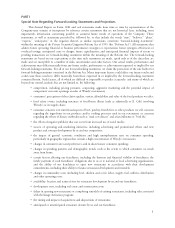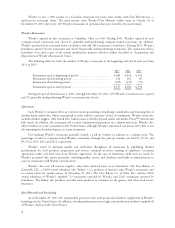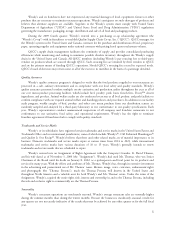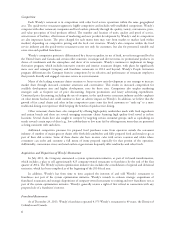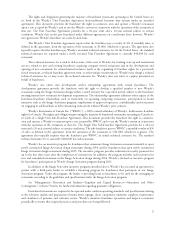Wendy's 2013 Annual Report Download - page 14
Download and view the complete annual report
Please find page 14 of the 2013 Wendy's annual report below. You can navigate through the pages in the report by either clicking on the pages listed below, or by using the keyword search tool below to find specific information within the annual report.Employees
As of December 29, 2013, the Company had approximately 37,000 employees, including approximately 2,500
salaried employees and approximately 34,500 hourly employees. We believe that our employee relations are
satisfactory.
Item 1A. Risk Factors.
We wish to caution readers that in addition to the important factors described elsewhere in this Form 10-K, we
have included below the most significant factors that have affected, or in the future could affect, our actual results and
could cause our actual consolidated results during fiscal 2014, and beyond, to differ materially from those expressed in
any forward-looking statements made by us or on our behalf.
Our success depends in part upon the continued retention of certain key personnel.
There were a number of changes in our senior management team in 2011 through 2013, including the
appointment of a new President and Chief Executive Officer. We believe that over time our success has been
dependent to a significant extent upon the efforts and abilities of our senior management team. The failure by us to
retain members of our senior management team in the future could adversely affect our ability to build on the efforts
we have undertaken to increase the efficiency and profitability of our business.
Competition from other restaurant companies, or poor customer experience at Wendy’s restaurants, could hurt
our brand.
The market segments in which company-owned and franchised Wendy’s restaurants compete are highly
competitive with respect to, among other things, price, food quality and presentation, service, location, convenience,
and the nature and condition of the restaurant facility. If customers have a poor experience at a Wendy’s restaurant,
whether at a company-owned or franchised restaurant, we may experience a decrease in guest traffic. Further,
Wendy’s restaurants compete with a variety of locally-owned restaurants, as well as competitive regional and national
chains and franchises. Several of these chains compete by offering menu items that are targeted at certain consumer
groups or dietary trends. Additionally, many of our competitors have introduced lower cost, value meal menu options.
Our revenues and those of our franchisees may be hurt by this product and price competition.
Moreover, new companies, including operators outside the quick-service restaurant industry, may enter our
market areas and target our customer base. For example, additional competitive pressures for prepared food purchases
have come from deli sections and in-store cafes of a number of major grocery store chains, as well as from convenience
stores and casual dining outlets. Such competitors may have, among other things, lower operating costs, better
locations, better facilities, better management, better products, more effective marketing and more efficient
operations. Many of our competitors have substantially greater financial, marketing, personnel and other resources
than we do, which may allow them to react to changes in pricing and marketing strategies in the quick-service
restaurant industry better than we can. Many of our competitors spend significantly more on advertising and
marketing than we do, which may give them a competitive advantage through higher levels of brand awareness among
consumers. All such competition may adversely affect our revenues and profits by reducing revenues of
company-owned restaurants and royalty payments from franchised restaurants.
Changes in consumer tastes and preferences, and in discretionary consumer spending, could result in a decline in
sales at company-owned restaurants and in the royalties that we receive from franchisees.
The quick-service restaurant industry is often affected by changes in consumer tastes, national, regional and
local economic conditions, discretionary spending priorities, demographic trends, traffic patterns and the type,
number and location of competing restaurants. Our success depends to a significant extent on discretionary consumer
spending, which is influenced by general economic conditions and the availability of discretionary income.
Accordingly, we may experience declines in sales during economic downturns. Any material decline in the amount of
discretionary spending or a decline in consumer food-away-from-home spending could hurt our revenues, results of
operations, business and financial condition.
10



